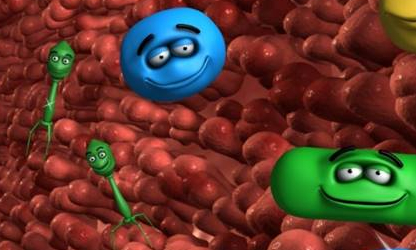

Superbug Killers Western scientists discovered a potent weapon against antibiotic-resistant bacteria in an unlikely place: Soviet-era medical labs
By Anna Kuchment NEWSWEEK INTERNATIONAL
Dec. 17 issue " Alfred Gertler had never been so ill. In 1997 the 45-year-old jazz musician was hiking in Costa Rica when he fell and broke his ankle. He contracted a staphylococcus infection so severe that flare-ups kept him in bed for weeks at a time. Antibiotics were of no use: the circulation in his ankle was too poor to transport the medicine to its target. When doctors told him that they might have to amputate his foot, Gertler buried himself in books and magazines, looking for a solution. He found one: bacteriophage therapy, a little-known medical treatment that doctors in the former Soviet Union had been using for decades.
LAST FEBRUARY, GERTLER flew to the Eliava Institute in Tbilisi, Georgia. He found doctors laboring by the light of kerosene lanterns in poorly heated buildings with just one hour of running water per day. They applied a solution of bacteriophages " tiny viruses that destroy bacteria " directly to his ankle. It worked. "The infection was completely gone in three days," says Gertler. He plans to have foot-saving surgery early next year. Soon it won't be necessary to fly to Tbilisi. Many scientists believe bacteriophages will be an important new weapon in the fight against antibiotic-resistant infections. In the past decade, chronic overprescribing of antibiotics has weaned new strains of superbugs, and pharmaceutical firms have begun to run out of drugs to fight them. Fortunately, biotech start-ups from Baltimore to Bangalore are developing phage treatments that fight infectious diseases such as tuberculosis and salmonella, as well as anthrax and other bioweapons. Even though the treatment has logged eight decades of use in eastern Europe, its success has been largely anecdotal. "[Soviet scientists] took for granted that phages work," says Nina Chanishvili, a senior microbiologist at the Eliava Institute. "They didn't feel they needed to justify how safe it was, and nobody bothered to build up any data on them."
That's what scientists are doing now, more than 80 years after phages were first administered in Paris to four patients with severe dysentery. (All four recovered.) The treatment was first popularized in Sinclair Lewis's 1925 novel "Arrowsmith," about a young doctor who stumbles upon a bacteria-eating virus. "You may have hit on the supreme way to kill pathogenic bacteria!" exclaims one character. At one time German and Red Army soldiers carried vials of phages in their medical kits, and the U.S. firm Eli Lilly marketed seven different phage preparations to fight staph, streptococcus and E. coli . Antibiotics, which proved more effective and simpler to use, eclipsed them in the 1940s, but now phages are undergoing a renaissance. "I call it "˜back to the future'," says Alexander Sulakvelidze, cofounder of Intralytix, a Baltimore biotech firm. Scientists still have some hurdles to overcome. One is political: the lingering distrust of Soviet medicine. Some doctors are also reluctant to administer live viruses for fear they'll make patients ill. (Experts are quick to point out that phages target bacterial " not human " cells.) And phages, like laser-guided missiles, are very specific: one phage kills only a specific subgroup of bacteria. (Salmonella, for example, has more than 2,400 subgroups.) Whereas antibiotics, medicine's weapons of mass destruction, kill many different types of bacteria in one go, a physician would need to make a very specific diagnosis before prescribing a phage treatment. To make it easier, scientists at Intralytix are developing phage "cocktails," and Phage Therapeutics in Seattle has genetically engineered superphages that attack bacteria across subgroups and species. When they eventually hit the market, phages will prove to have distinct advantages over antibiotics, say researchers. Practice has shown phages to be safe: no patient has ever been known to suffer an allergic reaction to them. That may be because phages are the most ubiquitous living organisms on earth, found in soil, water, plants and humans. And, unlike antibiotics, phages multiply at the site of an infection. "It's the only drug that makes more of itself as it works," says Richard Carlton, president of Exponential Biotherapies in New York. The tiny viruses " 200 million fit in a drop of water " kill by attaching to a bacterial cell and injecting phage DNA. Once inside, new phages replicate until the cell bursts, sending "daughter" phages scurrying off in search of more prey. The specificity of phages would be an advantage in treating patients whose immune systems have been compromised by AIDS or cancer treatment. Because antibiotics destroy good cells that keep bad ones at bay, these patients often succumb to deadly secondary infections. And even though bacteria can develop a resistance to phages as well as to antibiotics, researchers say it takes only a few days to isolate a fresh and effective phage, as opposed to years to make a new antibiotic.
Progress in introducing phages to Western medicine has been rapid, though marketable products are still at least three years away. Exponential Biotherapies recently completed the first phase of clinical trials for a treatment against the superbug VRE (vancomycin-resistant enterococci), which kills thousands of cancer and AIDS patients each year. Intralytix is working on a treatment for the same bacteria, and also has a patent pending for PhagoBioDerm, a phage-impregnated bandage that helps heal serious skin infections. The company, which expects to close its second round of financing in January (it is asking for $8 million), is about to move into its new lab: a 5,000-square-foot facility overlooking Chesapeake Bay, where its researchers find most of their phages. Other companies aren't far behind. Phage Therapeutics has gone public and hopes to start clinical trials in March for eyedrops that fight staph infections that can cause blindness if not treated quickly. "With antibiotics," says president and CEO Richard Honour, "it can take days for blood levels to get high enough [for the medicine to work]. But when you put a phage drop in the eye it begins to act immediately." Late last year Janakiraman Ramachandran, former president of AstraZeneca, found-ed Gangagen in Bangalore, India. With money from a U.S. venture capitalist who prefers to remain anonymous, three months ago he opened an office in Palo Alto, California, and plans to double its staff in the next year. Phage researchers are exploring the virus's effectiveness against anthrax " particularly strains genetically engineered to resist antibiotics. Intralytix and Exponential Biotherapies are also applying phages to salmonella and E. coli bacteria in poultry and meat products. One treatment being developed by Intralytix can be sprayed on eggs, chicks or chickens before packaging. Both companies have partnerships with meat-processing plants in the United States and western Europe. Nobody expects phages to be a magic bullet that will replace antibiotics. "They're an important addition to the tools we already have," says Sulakvelidze. "For some patients, they may prove to be the only thing that works." With superbugs on the rise, the number of such patients will surely grow.
-------------------------------------------------------------------------------- With Ian MacKinnon in New Delhi and Eve Conant in Moscow
© 2001 Newsweek, Inc.
Cover Image - 12/17/2001
Many scientists believe bacteriophages will be an important new weapon in the fight against antibiotic-resistant infections. "Sulakvelidze, co-founder of Intralytix, outside his firm's new lab. He says phages will be some patient's best hope"







